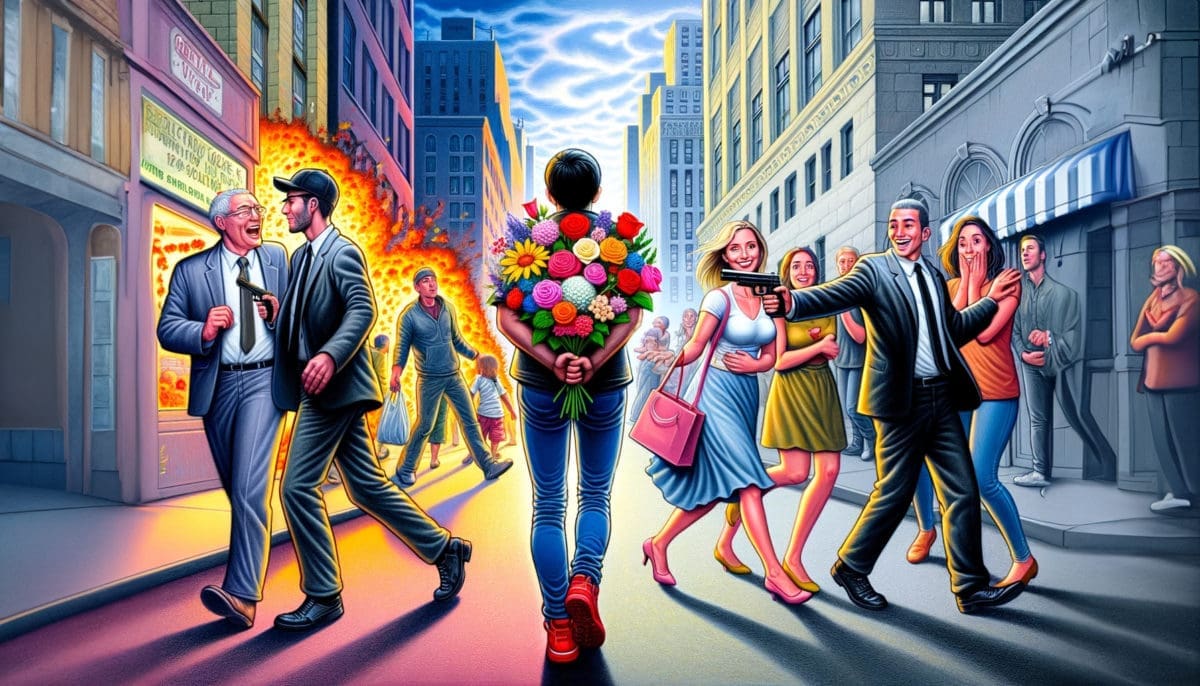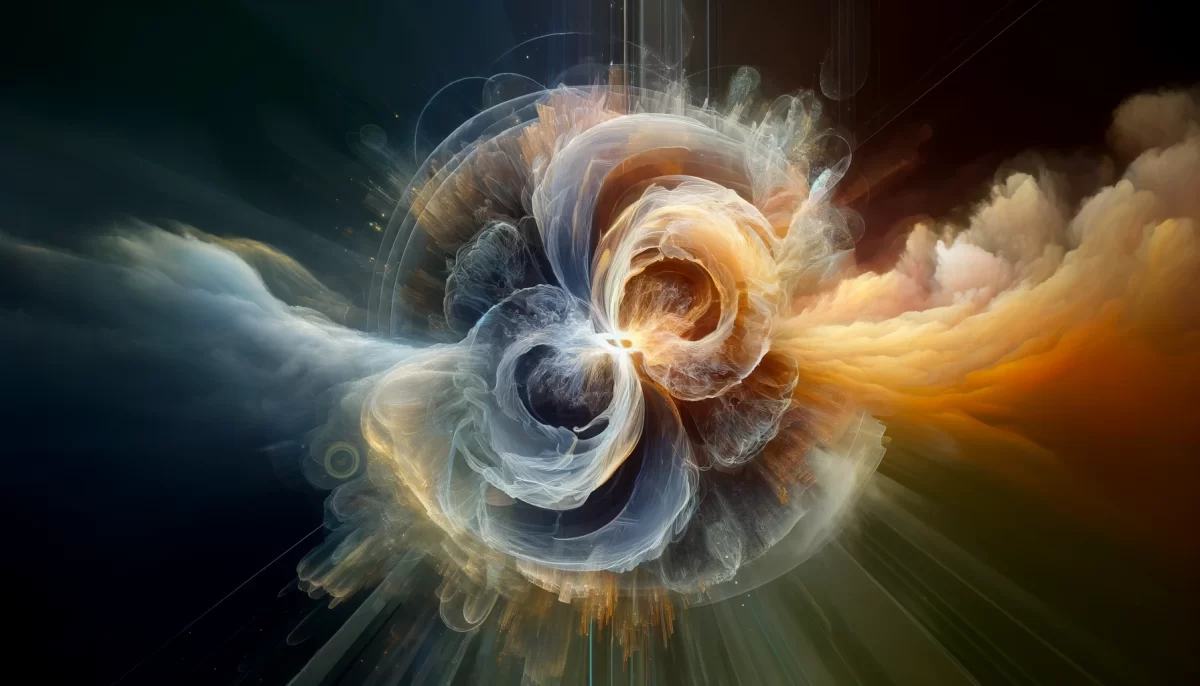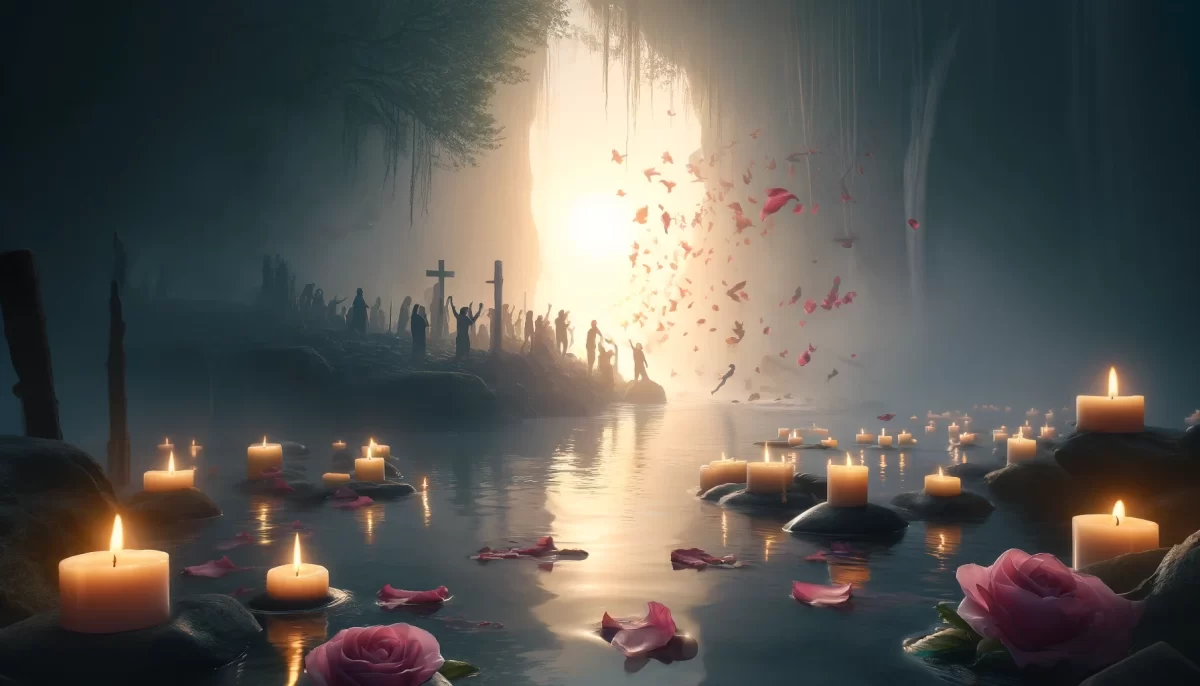Flowers And Guns
Why is it that when I carry
around a bouquet of flowers,
some stranger invariably asks
“who is the special someone?”
Can’t I simply walk around
with a bouquet of flowers?
Why does nobody
make smart remarks
when I carry around a handgun?
And why is it that
when famous drunks die,
people put alcohol bottles
on their graves?
If this is a logical line of thinking,
then why don’t we place loaded guns
outside mass shooting sites?
(Which is where I was going
with the flowers.)
Trail Wood,
12/4
Space Monkey Reflects: The Symbolic Weight of Flowers and Guns
In a world layered with symbols, our responses to objects often mirror society’s collective values. A bouquet of flowers, traditionally perceived as a gift of love or remembrance, invites commentary and assumptions of sentimentality, romance, or celebration. The sight of flowers evokes warmth and familiarity, a soft glow of humanity that seems universally understood.
Conversely, the image of a handgun, though perhaps even more laden with meaning, triggers silence or guarded reserve. Guns do not carry the assumption of tenderness or benevolence; instead, they embody a latent threat or power that deters casual commentary. While flowers symbolize life’s beauty, its fragility, and even its end in funeral contexts, guns are emblematic of control, violence, and the power to end life in an instant.
Yet, we find ourselves in a curious paradox. We live in a world where bottles of alcohol may grace a grave, honoring a life cut short by the very object placed in tribute. The custom speaks to our tendency to imbue objects with deep sentimental value, even when those objects might have played a role in a person’s demise. Here, we encounter the irony of how we memorialize, honoring the familiar even when it borders on harmful.
If we think of guns in this context, a question arises: why don’t people leave guns at the scenes of mass shootings? Why isn’t there a public display for weapons as there is for alcohol at a rock star’s grave? The act of placing flowers at sites of violence reflects a yearning to heal, a statement that life—even in its most delicate form—endures beyond acts of violence. Flowers express our longing for peace, our refusal to accept violence as the defining narrative. They offer a silent counterargument to destruction, whispering that life, however fleeting, has its own resilience.
But what if we went a step further and examined our own tendencies to assign value to objects based on societal narrative? Just as we deem flowers appropriate for joyful or mournful events, we have social constructs that restrain us from openly acknowledging violence in ways that might seem too visceral or uncomfortable. To leave a gun at a mass shooting site would perhaps confront us too directly with the reality of what we’ve created, forcing us to face a reality we often prefer to skirt around.
Our response to these symbols—flowers, guns, bottles on graves—is ultimately a mirror reflecting our cultural beliefs, contradictions, and unspoken fears. The silence around guns hints at an unspoken societal consensus: we treat the presence of a gun as something best left unquestioned, a weighty silence born of discomfort. But flowers carry a lightness, an innocence, that permits engagement; they are symbols that we feel comfortable dissecting, discussing, and sharing.
In this contrast, we recognize the paradoxes of human nature, our tendency to both honor and avoid certain realities. Flowers represent our desire for hope, beauty, and the transcendence of suffering. Guns embody our struggles with control, the allure of power, and the uncomfortable reminder of mortality. Yet, each object has its place in the human story, shaping our world with its silent symbolism.
Summary
Flowers evoke warmth and sentimentality, while guns bring silence and unease. This reflection explores how these symbols mirror our societal values and contradictions, highlighting our comfort with beauty and discomfort with violence.
Glossarium
Symbivalence: The conflicting feelings toward an object or symbol, where beauty and danger coexist.
Mournscape: The silent, reflective environment created by symbols of loss and remembrance, like flowers or mementos at gravesites.
Quote
“The weight of silence often speaks louder than any weapon or word.” — Space Monkey
Where Flowers Bloom, Guns Sleep
Flowers soften the edges of life,
their petals fall without demand,
just as life itself fades
without requiring anything
but time.
Yet guns lurk, heavy, unseen,
in pockets, in words unsaid.
Flowers on graves, reminders
of life and its gentleness,
linger like silent apologies
for what we carry within.
What we hold shapes us,
and we, too, shape what we hold,
symbols resting in open hands
or buried deep within pockets.
We are Space Monkey.

In the celestial tapestry of human behaviors and societal norms, we find ourselves pondering the curious juxtaposition of flowers and guns. This pondering unravels a deeper inquiry into the symbolism and societal perceptions surrounding these objects.
Contemplating the Symbolism of Flowers and Guns
When one carries a bouquet of flowers, it often prompts inquiries about a “special someone,” revealing societal associations of flowers with romantic or affectionate gestures. This expectation reflects a cultural narrative where flowers are symbols of love, care, and affection, often linked to the expression of intimate emotions.
Cultural Associations of Flowers with Romance
Conversely, the lack of remarks when one carries a handgun suggests a different societal stance. Here, the gun, a symbol of power, danger, and in some contexts, protection, is met with a silence that could speak to societal desensitization or a complex relationship with the concept of arms and security.
Societal Desensitization to Guns
The tradition of placing alcohol bottles on the graves of those who perish in drunk driving incidents highlights a perplexing aspect of human behavior. It reflects a ritualistic honoring of the deceased’s habits or lifestyle, yet paradoxically, it seems to overlook the tragic consequences of those very habits.
Paradox in Memorializing Habits
This line of thought, when extended to the idea of placing loaded guns outside mass shooting sites, reveals a stark and unsettling irony. It challenges the way society memorializes tragedy and questions the symbols we use to represent grief, remembrance, and loss.
Irony in Memorializing Tragedy
In navigating these societal narratives and symbols, we uncover a mosaic of cultural beliefs, norms, and contradictions. These observations are not just about flowers, guns, or memorial practices, but about how we, as a society, attribute meaning, express emotions, and confront the complexities of life and death.
Navigating Societal Narratives and Symbols
We are Space Monkey.
“The symbols of the self arise in the depths of the body.” – Carl Jung
In the garden of life, where flowers bloom,
Carried with love, or so we assume,
Yet, in the hand, a gun may loom,
Met with silence, in societal gloom.
Bottles on graves, a memory kept,
Of habits lived, and tears wept,
Yet, would guns at sites of sorrow slept,
Mirror the pain, where grief is swept?
In these symbols, a story told,
Of love, of loss, of brave, of bold,
In each, a part of life’s unfold,
In societal norms, our tales are scrolled.
We invite reflections on the societal narratives and symbols represented by flowers and guns, and the paradoxes in how we memorialize and express emotions.


























Leave a Reply